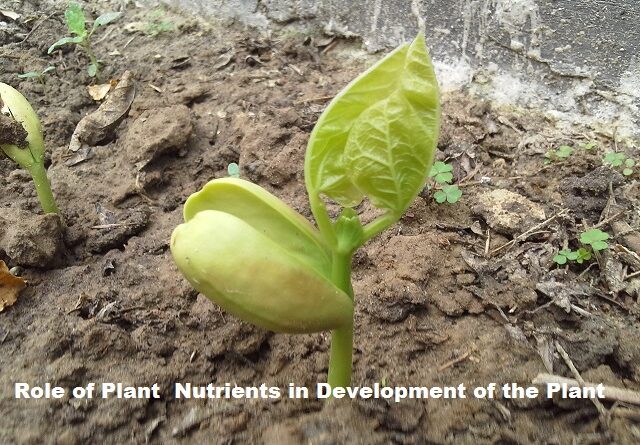Role of Plant Nutrients in Development of the Plant
Role of Plant Nutrients in the development of the Plant
Plants are unique organisms that live, grow and reproduce by taking up water and mineral from the soil carbon dioxide from air and energy from the sun to form their tissues as well as the miraculous biomolecules which build up a vast array of grains, fruit, fibers, fower, timbers, gums, resins, essential oils, amines sugars, alkaloids, etc. From a limited number of chemical been drawn on soil and air. These elements are known as a plant nutrient
Plant Nutrients
Plant nutrients are chemical elements that are essential for proper growth and development of plants, deficiency of one of which develops a characteristic symptom and hinders proper plant growth. Sixteen elements are recognized to be essential to all plants for their normal growth and developments. These essential elements are carbon, hydrogen, oxygen which are derived from the air and water and nitrogen phosphorus, potassium, calcium, magnesium sulphur, iron, tine, manganese, copper, boron, molybdenum and chlorine, which is supplied by the soil in varying quantities
Nitrogen, phosphorus, and potassium are used in large quantities by plants and are called m or, macro, or primary nutrients. Calcium, magnesium and sulphur are required in relatively smaller but inappreciable quantities and called secondary nutrients. Iron, zinc, manganese, copper, boron, molybdenum and chlorine are required by plants in smaller quantities for their growth and development hence called micronutrients or trace elements.
A fertile soil must contain all these essential plant-nutrients in sufficient quantity, in balanced proportion, and is available form so that plants can use them readily for their proper growth and to its full potential.
Each of the aforesaid 16 elements has a definite and specific metabolic function to perform in the growth and development of the plants. A deficiency of any of these nutrients causes some abnormal conditions and upsets the growth of the plants. The main physiological role of these nutrients are the as follows:
Carbon, Hydrogen and Oxygen
These three elements are very essential for all plants and form about 94 percent of the dry weight of the plants. They are also major constituents of all organic chemical compounds of which the plant is made and they are concerned with different metabolic reactions, vital for growth and development of plants, The intricate process by which the green plants, making use of solar energy, convert to chemical energy in form of sugar and starch from atmospheric carbon dioxide and soil water is a unique process called photosynthesis
Nitrogen;
Nitrogen is a major structural constituent of the cell and cell organelle plays an important role in plant metabolism by virtue of being an essential constituent of metabolic active compounds like amino acids, proteins nucleic acids, porphyrins, flavins, purines, pyrimidines, nucleotides, flavin nucleotides, enzymes, coenzymes, alkaloids, etc.
Phosphorus
Like nitrogen, phosphorus is a structural component of the cell membrane and cell organelle (Chloroplasts, Mitochondria. Ribosomes, etc. It is a constituent of nucleic acid, phosphatides, nucleoproteins. Navin and pyrimidine nucleotides pyridoxal phosphate and thiamine pyrophosphate, coenzymes -ii, phosphoglycerates, etc. It is involved in basic reactions of photosynthesis activation of the number of enzymes.
Potassium
It plays an important role in the maintenance of cellular organization permeability of the membrane, the balance of water in protoplasm. It acts as an activator of enzymes involved in protein and carbohydrate metabolism. Potassium helps in carbohydrate translocation, synthesis of protein, maintaining water balance in the system. It enhances the plant’s ability to resist cold, diseases, and other adverse conditions, It is essential for grain or seed development to improve the quality of fruits, seeds, and vegetables (color, flavor, and size)
Calcium
Calcium is an important constituent of cell walls (as calcium pectate), it regulates the permeability of the membrane, balance the hydration of protoplasm. It acts as a detoxifying agent by neutralizing organic acids in plants.
Its deficiency causes chromosomal abnormalities, reduces mitosis and cellular development, affects adversely the nitrogen fixation by leguminous plants.
Magnesium
It is a key element of chlorophyll without which photosynthesis does not occur. It promotes uptake and translocation of phosphorus, movement of sugars
Sulphur
Sulphur is a constituent of amino acids (cysteine, methionine), Vitamins (thiamine, biotin), coenzyme A. ferredoxin, and glutathione. It helps in the synthesis of oils and the formation of chlorophyll
Iron
It is necessary for the synthesis and maintenance of chlorophyll in plants. It is a constituent of porphyrins. cytochromes, heme-Terrodoxin in plants and hemoglobin in root nodules.
It plays an essential role in nucleic acid metabolism, RNA metabolism, chloroplast metabolism, oxidative phosphorylation, etc. Iron is a structural constituent of many pigments.
Zinc
It is involved in the biosynthesis of plant hormone, IA.A. It is essential as a cofactor of many enzymes (metalloenzymes).
Its deficiency causes to reduce the photosynthesis and nitrogen metabolism, delays flower setting and fruit development.
Manganese
It acts as a catalyst in several important enzymatic and physiological reactions in plants. Activates enzymes that are involved in the metabolism of nitrogen and the synthesis of chlorophyll.
The deficiency of Manganese causes to decrease the levels of photosynthesis, accumulation of soluble sugars, and nitrogenous compounds.
Copper
Copper is a constituent part of cytochrome oxidase and a component of many enzymes, prosthetic groups of enzymes. Promotes the formation of Vitamin A in plants.
Boron
It increases permeability in the cellular membrane and facilitates carbohydrate transport. Involved in lignin and Protein Synthesis, it increases calcium uptake and maintains the potassium: calcium ratio in plants.
Molybdenum
Molybdenum is a constituent part of flavin-bound enzyme, nitrate reductase, and nitrogenase, involved in nitrogen fixation. It is associated with nitrogen utilization and the synthesis of amino acids. Its deficiency reduces the organic phosphorus/inorganic-phosphorus ratio.



